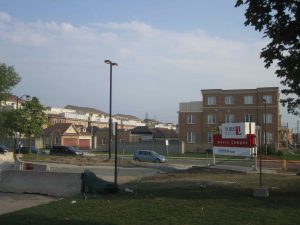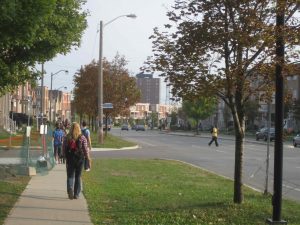By Roger Keil
The inner suburbs in Toronto are places of great contradiction: hyperconnectivity and total lack of connectivity; universities and strip clubs; airport runways and bicycle lanes; highrises and bungalows, oldtimers and newcomers. They are also the site of disaster and planning failure: Sometimes it is the catastrophic kind like the Sunrise propane fire or the Finch washout; other times it is the mundane kind such as the daily struggles of non-drivers to survive in a landscape made for cars in a pathetically underserviced system, or fires in student rooming houses at York University.
 Meant to be solutions to earlier urban constellations, the inner suburbs have now become the site and source of new problems themselves.
Meant to be solutions to earlier urban constellations, the inner suburbs have now become the site and source of new problems themselves.
Yet here is a radical idea: In order to understand their challenges and potentials, we need to move away from the idea of suburbs as subordinate to the inner city, as derivative of the inner city, and see them in their own right.
The way to do this is by looking at them not as pristine, semi-rural, seemingly non-urban extensions of the inner city but urban constellations that have developed a dynamics of their own.
They are now city. The word suburb does not describe them very well anymore. People from the historical centre need to stop calling other parts of the city sub-anything in order to remove important obstacles from necessary metropolitan or regional conversations.
Our conventional view of urban geographies suffers from a specific shortsightedness. While we imagine the inner city as constantly changing and full of creative potential, we have been treating suburbs as static, frozen in time, and unchangeable. (This is, to some degree, the unfortunate legacy of Jane Jacobs, and the flipside of the creative city mantra.)
From the vantage point of inner city observers, the suburbs appear as Mordor in Lord of the Rings. A threatening, unknowable territory. Jane Jacobs, for example, said once: “[Cities] … differ from towns and suburbs in basic ways, and one of these is that cities are, by definition, full of strangers.” We know that this is not the case. Many downtowns are now Disneyfied, predictable and uniform. The inner suburbs are raw, unpredictable and diverse, full of neighbours and strangers alike.
Spatially sequestered from the master discourse of urbanity, the inner suburbs are also locked in some time warp of immobility, a museum of suburbanity where no change is imaginable. Yet, if we “take a drive through the sprawl, through these towns they built to change” to borrow the words of Montreal’s Arcade Fire, (The Sprawl 1), we may actually see how much they are not what they used to be.
In fact, suburbs have now taken on new roles in the formation of the global city, where important demographic, economic and cultural connections come together.
Still, Toronto’s inner suburbs are treated like shrinking cities inside a booming metropolis. They are not actually shrinking like Detroit, for example. But they are dealt with much like steel towns and motor cities: as if they were relics of a bygone era and needed major surgeries. In the most extreme of these positions, the populations, rather than the physical environment of the inner suburbs are blamed for their lack of fit with the requirements of a flexibilized labour market built on creativity and knowledge. Like the steel mills of the industrial towns, the inner suburban residents and workers are considered dead capital in the creative economy which is considered naturally at home along Queen Street West and the graffitied and gentrified alleyways of the former working class neighbourhoods downtown.
The tendency to treat suburbs this way has its origin among urbanists and pundits of all political and ideological stripes. Those on the political Right see the tower and bungalow neighbourhoods as products of earlier (welfare) state-sponsored city building gone wrong (i.e. underserviced, overtaxed, etc.). Those on the political Left, particularly those from downtown, see the suburbs as either entirely lost to urbanist intervention of any sort; or, even worse, the object of colonizing efforts that focus on remedying their automobility, commercial culture (malls!) and conservatism as if those were in-built diseases with which their residents are infected. In both cases, the inner suburbs appear as caricatures.
Following the German architect Tom Sieverts, my colleague Douglas Young and I have long called the inner suburbs in-between cities. Toronto’s inner suburbs are neither old downtown nor new suburb but complex urban landscapes of mixed density, use and urbanity. The existing focus on the premium spaces of urban regions (the core infrastructures, the airport, the financial core, the temples of high culture like museums and concert halls, the research and medical institutes, the exclusive central and peripheral residential areas, etc.) eclipses the less visible spaces that lie in-between. The in-between city finds little political representation, hardly any symbolic valuation, and often becomes residual terrain in metropolitan governance. (Sieverts, 2011:20; Young and Keil, forthcoming).
 The in-between city in Toronto is particularly vulnerable to oversight by planners and decision-makers as it sits at the political margins of the core metropolis. They are literally out of sight to many who commonly make decisions on metropolitan matters. But they are not just a far away part of Toronto, they are also neighbours of other parts of the urban region.
The in-between city in Toronto is particularly vulnerable to oversight by planners and decision-makers as it sits at the political margins of the core metropolis. They are literally out of sight to many who commonly make decisions on metropolitan matters. But they are not just a far away part of Toronto, they are also neighbours of other parts of the urban region.
The inner suburbs have as their counterpart in the new suburban areas, dynamic, economically wealthy, technologically advanced and connected neighbourhoods. For every Jane and Finch, there is a neighbour called York University, for every Rexdale, there is a Vaughan or Brampton just across the street, for every Malvern, there is a Markham in the vicinity. Not only do we accept the stark contrasts of opportunity, wealth and mobility in those contiguous yet different urban areas, we also have no political processes to deal with their difference. By contrast, the current political and power systems reinforce those differences.
People in the inner suburbs tend to be at the receiving end of more or less good intentions by outsiders. State and market strategies have been applied to the inner suburbs since their inception. In fact, their very existence was strategic. They had a purpose. They were supposed to relieve growth pressures on the inner city. In fact, they were born as products of centralized, downtown decision-making processes, afterthoughts of the increasing realization that the way cities grew since the industrial age was coming to an end.
More recently, some have developed a concept for environmental and social refurbishment of the building stock in the highrise neighbourhoods. Others have made subways the battle cry in a war on the car, which is supposed to benefit the under-serviced and marginalized populations of the periphery. I don’t see it as my task here to make specific political recommendations either way but it is clear that while physical repair, mobility improvements and political representation are key items that need attention in the inner suburbs, the area’s main challenge is the unhealthy mix of racialized poverty that has come to define them. It is highly unlikely that those problems can be repaired with place based strategies alone.
Statement at Chief Planner Roundtable The Next Generation Suburbs at the invitation of Jennifer Keesmaat, April 2, 2013, City Hall, Toronto (http://www.toronto.ca/planning/chiefplannerroundtable/)
Sources:
McMahon, M., Keil, R. & Young, D. (2011). In-Between Infrastructures: Imagining New Forms of Techno-social Politics in the Contemporary Canadian Metropolis. City Institute Occasional Paper Series.
Sieverts, T. (2011). The in-between city as an image of society: From the impossible order towards a possible disorder in the urban landscape. In D.Young, R.Keil, & P.B Wood (eds.) In-Between Infrastructure: Urban Connectivity in an Age of Vulnerability. Kelowna, B.C.: Praxis(e)Press, pp. 19-27.
Young, D. & Keil, R. (2014). Locating the Urban In-Between: Tracking the urban politics of infrastructure in Toronto. International Journal of Urban and Regional Research.
Young, D., Wood, P.B. & Keil, R. (eds.) (2011). In-Between Infrastructure: Urban Connectivity in an Age of Vulnerability. Kelowna, BC: Praxis(e) Press.


2 comments on “Welcome to Toronto after suburbs”